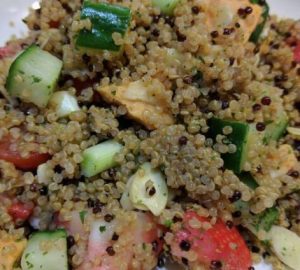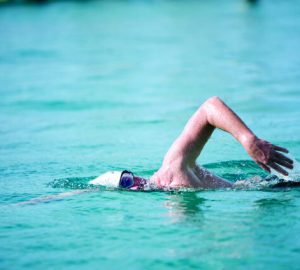Ready to race
So, the one big event of the season is coming up and, with all the training and preparation that you have put in, you want to ensure that when you hit the water you are in the best possible shape that you can be. We take a back to basics look at what it takes to get there..
Weeks leading up to the event
If you want to perform at your best in your swim, then you need to be nicely rested, fuelled and hydrated. If you have been training hard for the event in the months leading up to it, then you will need to complete a ‘training taper’. A taper essentially refers to a progressive reduction in the volume of training that you are completing, by around 40 to 60 per cent for the eight to 14 days prior to an event, while maintaining the training frequency and intensity. This reduction in training volumes allows you to both physiologically and psychologically recover from the training you have completed over the past few months, while ‘keeping the engine ticking over’ with some shorter, high-intensity sessions. If you stop training altogether, you will lose some of the hard earned gains in fitness that you will have worked towards and if you don’t reduce the training load enough, you will feel tired and won’t reach peak fitness for your event.
In the weeks leading up to the swim, you want to ensure that you are putting in some of your biggest blocks of training and accumulating fatigue. Eight to 10 days before the event, you want to start your taper. Through reducing the volume of training (so essentially doing fewer hours per week), your body goes into a state of compensation and if you time it right, you’ll hit race day in a ‘super compensated’ state and will be in your best physical shape. How you respond to a taper is a very individualised response, so experience will help you develop the best strategy.
Training sessions in the weeks leading up to the event are also a great time to complete some swims in a similar environment to those that you are looking to race in. These will allow you to experience and acclimatise to the conditions, and make you aware of the challenges that you may face come the event itself. These swims are also a good opportunity to practise your big day fuelling and hydration strategy to ensure what you have lined up is executable during the event.
Days leading up to event
As you get closer to the event and your training tapers off, the focus can now move onto carbohydrate loading, to ensure you have the best possible fuel reserves stored up for the event. The greater the distance of the event, the more important it will be to have sufficient carbohydrate available, particularly as the event distance increases beyond 5km. The more carbohydrate you can cram into your muscles, the more fuel you have to power you through high intensity efforts, and the better your performance is likely to be. A high carbohydrate diet (around 10 to 12grams of carbohydrate per kilogram of body weight, per day) with moderate protein and low fat intake for the two to three days prior will maximise these stores.
There’s an array of carbohydrate-rich foods that you can use to carbo load. Food is often rated on the Glycaemic Index (GI). High GI food such as sweets, honey, non-diet sugary drinks, rice cakes, baked potatoes and breakfast cereals are digested very quickly and cause a rapid rise in blood sugar. In comparison, low GI foods such as fruit, lentils, beans and chick peas take much longer to be digested and cause a very slow rise in blood sugar. From a general health perspective, a diet that includes more low GI foods is better, because they contain dietary fibre, some protein and various vitamins and minerals as well as keeping insulin release and pancreatic strain to a minimum. While carbohydrate loading however, high GI carbohydrates will allow you to get a greater carbohydrate intake. In essence, gorging on the less healthy carbohydrates for two to three days prior to a race isn’t going to have a significant impact on your health and will make loading easier. You will also need to ensure that you are hydrated during this time too, as for every gram of carbohydrate that you store as glycogen, you will also store 3 grams of water. During this period, consuming smaller more frequent meals will help ensure that you don’t have any problems stomaching it.
Around 24 hours before the event, there is another trick on offer to help you maximise your carbohydrate reserves. First of all, complete a 15 minute warm up followed by a 3 minute all-out interval effort. Follow this immediately with a high carbohydrate meal (or ideally a sports recovery drink) and it can help to further increase your muscle glycogen stores.
The night before the event
Relax and get a good night’s sleep. Stay away from smartphones, tablets and laptop screens in the hours before bed, as the light they emit will reduce your sleep quality. Have everything in place ready for the next day to avoid stress the next morning.
Morning of the event
This is your final chance to ensure your fuel reserves are ready for the event. Aim to consume a good sized meal with around 1 to 4 grams of carbohydrate per kilogram of body weight, (so for a 70 kg person, this is somewhere between 70 to 240 grams of carbohydrate) three to four hours before the start of your swim. Something like a bowl of porridge or beans on toast are good options. Use a meal you are comfortable with and one you know is well tolerated by your stomach. This is also a good time to ensure you are on top of your hydration. If you do need to consume anything between your last meal and the start of the event, make sure that it is light and easily digestible (low fat essential) and avoid eating in the hour before the start.
The swim
Once the gun has sounded, the focus can shift onto fuelling for the swim again. This will still be important, even after a successful carbohydrate loading regime and especially if the event is particularly long. If your carbohydrate stores run dry, your pace will plummet and although carbohydrate loading will have afforded you some extra distance at a strong pace, the only way to ensure consistency to the end is to ingest some external sources of carbohydrate whilst you’re swimming. Remember that every gram of carbohydrate that you consume while you exercise is a gram of carbohydrate you do not use from your stores, so effectively it allows your stores to last longer.
Aiming for an intake of around 60 to 90grams of carbohydrate per hour will optimally cover fuelling needs, but this intake is only achievable through the use of formulated energy products. Due to the limited opportunities to feed during an open water swim these will offer an easy way of getting sufficient fuel in at the feeding zones. There is the option to use other food sources, but ensure that anything consumed has a low fat and fibre content, and be aware, depending on what you take onboard, the absorption rates will be significantly less than using optimised products (40 to 60g per hour rather than 90g). In hotter conditions, or when perspiration rates are high, you will also need to address your hydration needs. The latest research suggests drinking to thirst, which we subscribe to, but aiming to drink ‘slightly ahead of thirst’ we feel is an even better strategy. Ideally, consuming electrolyted energy drinks as a means of simultaneously rehydrating and fuelling in warmer conditions will ensure adequate salt intake too.








